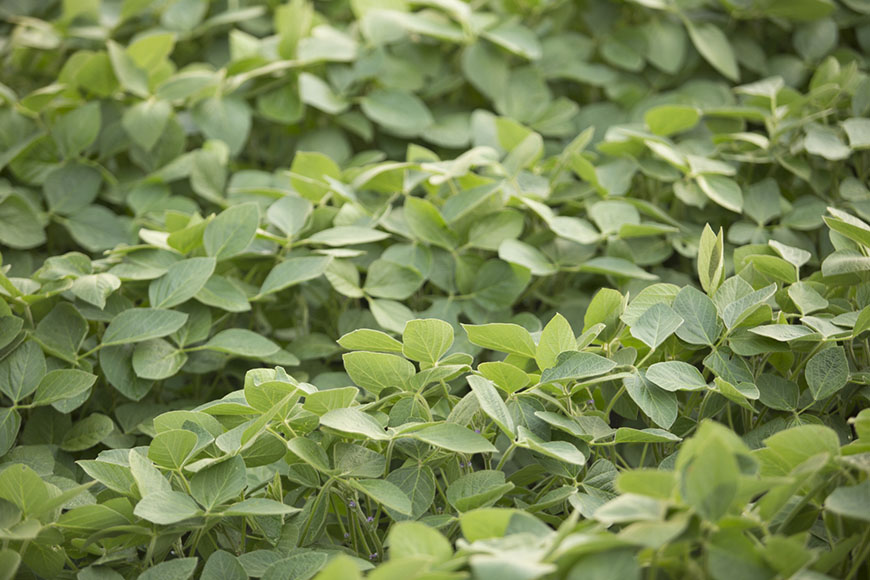Tips for Achieving 100-Bushel Soybeans, Part One: Plant Smart

Most growers have heard about Dr. Fred Below and his extensive research on the secrets to obtaining 300-bushel corn and 100-bushel soybeans. We’ve developed six steps to achieving 100-bushel soybeans, based on extensive research through our Answer Plot® Program and ag technology offerings.
1. Variety selection
Soybean placement should not be approached as one-size-fits-all. Agronomists can help you use data to select the best soybean variety for a particular soil type. Make sure you are capitalizing on new technology in varieties to increase your success on even the toughest acre.
For example, let’s say you have a maturity range of 0 to1 across your territory, making selection important. The Top 10 interactive charts below show which varieties perform best on coarse, medium and fine soil types. Just look at the difference between R2T00800 on medium soil (19 percent higher than the average) versus on coarse soil (1 percent higher than the average). For easy math, if the trial averaged 50 bushels, by placing this variety on medium instead of coarse soil, the potential yield increase could reach roughly 9.5 bushels based on variety selection alone.


2. Early planting
Farmers who have traditionally gotten their soybean crop in the ground before May 5 have seen no effects on yield. However, according to University of Minnesota Extension research, yield loss jumps to 6 percent when beans are planted by May 20, and to nearly 30 percent by mid-June. Monitoring rainfall and soil saturation in your fields can help you plan accordingly to get soybeans in the ground early.
3. Premium seed treatment
Early planting into cold, wet soils can pose disease and emergence issues. Using a quality seed treatment on soybeans can help address this. Warden® CX seed treatment is proven to increase yield over fungicide alone by nearly 3.5 bushels. To learn more about seed treatment options, download the free WinField Publications App in the iTunes® Store to access our Crop Protection Product Sell Sheets, where you can find information on seed treatments starting on page 201.
Learn more about the right technology for your soybean plan this year on answertech.com.
Part two of this series outlines key management considerations for 100-bushel soybeans. Read it here.
1. Variety selection
Soybean placement should not be approached as one-size-fits-all. Agronomists can help you use data to select the best soybean variety for a particular soil type. Make sure you are capitalizing on new technology in varieties to increase your success on even the toughest acre.
For example, let’s say you have a maturity range of 0 to1 across your territory, making selection important. The Top 10 interactive charts below show which varieties perform best on coarse, medium and fine soil types. Just look at the difference between R2T00800 on medium soil (19 percent higher than the average) versus on coarse soil (1 percent higher than the average). For easy math, if the trial averaged 50 bushels, by placing this variety on medium instead of coarse soil, the potential yield increase could reach roughly 9.5 bushels based on variety selection alone.


2. Early planting
Farmers who have traditionally gotten their soybean crop in the ground before May 5 have seen no effects on yield. However, according to University of Minnesota Extension research, yield loss jumps to 6 percent when beans are planted by May 20, and to nearly 30 percent by mid-June. Monitoring rainfall and soil saturation in your fields can help you plan accordingly to get soybeans in the ground early.
3. Premium seed treatment
Early planting into cold, wet soils can pose disease and emergence issues. Using a quality seed treatment on soybeans can help address this. Warden® CX seed treatment is proven to increase yield over fungicide alone by nearly 3.5 bushels. To learn more about seed treatment options, download the free WinField Publications App in the iTunes® Store to access our Crop Protection Product Sell Sheets, where you can find information on seed treatments starting on page 201.
Learn more about the right technology for your soybean plan this year on answertech.com.
Part two of this series outlines key management considerations for 100-bushel soybeans. Read it here.


